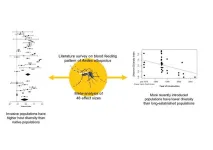(Press-News.org) CRISPR is a revolutionary tool that allows scientists to precisely modify the genome and gene expression of cells in any organism. It’s a reagent—a substance that facilitates a reaction—that combines an enzyme with a programmable RNA capable of locating specific genetic sequences. Once guided to the correct spot, the enzyme acts like a pair of scissors, cutting, replacing, or deleting sequences of DNA.
Researchers are now using the technology to, among many things, treat genetic diseases, develop medical therapeutics, and design diagnostic tools.
“CRISPR is very powerful, but it comes with side effects,” says Lehigh University bioengineering researcher Tomas Gonzalez-Fernandez, an assistant professor in the P.C. Rossin College of Engineering and Applied Science. “By modifying one gene, we can switch on or switch off many different genes that are associated with that gene, leading to unexpected results."
Gonzalez-Fernandez and his team recently received a grant from the National Science Foundation to address this side effect, specifically when it comes to modifying genes for desired therapeutic outcomes. Gonzalez-Fernandez has put together an interdisciplinary team with Rossin College faculty members Yu Zhang, an assistant professor of bioengineering, and Lifang He, an assistant professor of computer science and engineering, as well as Joshua Graham, a third-year PhD student in bioengineering advised by Gonzalez-Fernandez. Together, they are applying computer modeling and deep learning to predict the broader impacts of CRISPR gene edits on the genome.
“Machine learning has been used for enhancing CRISPR’s precision before, but this is the first time it’s being used to create a surrogate genome model,” says Gonzalez-Fernandez. The model will allow the team to simulate the effects of altering a single gene on the entire genome, enabling them to predict and avoid unintended consequences. It will also help in both the assessment and identification of novel genetic targets.
“So if we have a specific therapeutic application, but we don’t know what gene to modify, the model will help us identify different candidates,” he says. “It will also help us identify novel genes that no one has explored before. The genome is so huge and there are so many genes that we don’t yet understand.”
Gonzalez-Fernandez credits Graham with incorporating machine learning into the project. The PhD student, who is supported by an NSF Graduate Research Fellowship, became intrigued by the potential of applying the technology after taking a machine learning course taught by Zhang.
“Josh’s insight was pivotal,” says Gonzalez-Fernandez. “He wanted to apply the machine learning techniques he was learning in class to our CRISPR challenges, and it turned out to be exactly what we needed to make informed, predictive decisions about gene editing.”
Their approach has broad implications for various fields, including cancer treatment and musculoskeletal applications. For instance, the team has identified gene candidates that can enhance the differentiation of induced pluripotent stem cells into cells that are more effective at fighting cancer. (Induced pluripotent stem cells, or iPSCs, are capable of differentiating into any cell type in the body.) Similarly, they’ve found genes in mesenchymal stromal cells—stem cells that can differentiate into bone, cartilage, muscle, and fat cells—that can improve their differentiation into cartilage, which can enhance the treatment of conditions like osteoarthritis.
In order to function, however, CRISPR must penetrate a cell’s nucleus. And so the second part of the NSF grant focuses on the side effects of how that machinery—the enzyme and the RNA—is delivered to cells via nanoparticle-based vehicles.
“Thanks to these nanoparticles, the CRISPR machinery can enter the nucleus where it will do its magic,” he says. “But we have seen that the nanoparticle itself can negatively affect the cells. So we’ll use different computer modeling techniques to predict how these mechanisms affect the capacity of the stem cells to differentiate and survive.”
The ultimate goal, he says, is to make CRISPR safer and more reliable. By refining its use, the team hopes to expand its applications to include tissue regeneration and increasing the therapeutic capacity of stem cells.
Gonzalez-Fernandez says he enjoys the interdisciplinary nature of the effort, which brings together a variety of fields and techniques.
“How can we combine everything from computer science to modeling to genetic engineering and molecular biology to address a really significant problem of CRISPR?” he says. “It’s technically very challenging to address, but the potential is vast. This technique we’re developing could open up a range of treatment and therapeutic applications that could target a wide variety of diseases.”
Related Links
NSF Award Abstract (2347637): "ERI: Integrating Non-Viral CRISPR Gene Activation and Deep Learning for Biomanufacturing..."
Faculty Profile: Tomas Gonzalez-Fernandez
Tomas Gonzalez-Fernandez Lab: Advanced Tools for Engineering Smart Cells and Materials
Faculty Profile: Yu Zhang
Faculty Profile: Lifang He
NSF Graduate Research Fellowship END
Advancing CRISPR: Lehigh University engineering researchers to develop predictive models for gene editing
Interdisciplinary research funded by NSF will leverage artificial intelligence and advanced computer models to improve outcomes and expand the tool’s medical applications
2024-10-07
ELSE PRESS RELEASES FROM THIS DATE:
Protecting confidentiality in adolescent patient portals
2024-10-07
Weill Cornell Medicine researchers found that the possibility of parental disclosure through online patient portals led older adolescents to hesitate in sharing complete health information with doctors, putting them at risk of missed diagnoses and treatments. The paper noted that confidentiality concerns were increased among females and those who are sexual and gender minorities.
The results, published Oct. 7 in JAMA Pediatrics, are based on a national online survey that targeted 18 to 26 years olds who ...
Gatling conducting digitization project
2024-10-07
Benjamin Gatling, Associate Professor, English, College of Humanities and Social Sciences (CHSS), is set to receive funding for a project in which he will digitize a significant portion of the archive of the Folklore Fund at the Rudaki Institute of Language and Literature in Dushanbe, Tajikistan.
Gatling aims to train local archive staff in best practices, the preservation of materials, and digitization and metadata creation for the majority of the archive’s holdings, as well as the curation of digitized materials.
The archive’s holdings include bound notebooks, notecards, ...
Regenstrief researcher awarded $1.9 million CDC grant
2024-10-07
INDIANAPOLIS -- Jill Inderstrodt, PhD, MPH, has received notification of a five-year, $1.9 million collaborative grant to improve health and the care of people living with congenital heart defects (CHD).
Awarded by the Centers for Disease Control and Prevention, Dr, Inderstrodt will lead a multidisciplinary team from the Indiana University Fairbanks School of Public Health and the Regenstrief Institute. Also part of the research team is Brian Dixon, PhD, MPA, a Regenstrief researcher, Fairbanks School professor and interim director of the Regenstrief Center for Biomedical Informatics.
“I am honored to lead this initiative alongside ...
Independent expert report: The Human Brain Project significantly advanced neuroscience
2024-10-07
The European Commission (EC) has released the 10-year assessment of the Human Brain Project (HBP), an EU-Flagship initiative that concluded in 2023. The report was authored by a panel of independent scientific experts. Their assessment of the HBP’s development and results over the full 10 years comes to a strongly positive conclusion. The report highlights that the HBP made major contributions and had a transformative impact on brain research. One of the main outcomes of the HBP is EBRAINS, the open research infrastructure ...
Wu conducting molecular modeling of DR domain of HIV restriction factor PSGL-1
2024-10-07
Yuntao Wu, Professor, Molecular and Microbiology, School of Systems Biology, College of Science, is studying the structure of dicameric repeats (DR) of PSGL-1, a host protein that inhibits HIV virion infectivity.
These are repeated stretches of 10 amino acids with numerous O-glycosylated threonines and prolines.
Wu and his collaborators hypothesize that the structural rigidity and glycosylation of dicameric repeats affect anti-HIV activity.
The researchers have two aims.
First, they aim to determine the structure-function of DR.
Second, they intend to test and validate the anti-HIV activity of PSGL-1 (P-selectin glycoprotein ligand 1) that inactivates ...
Nguyen working to make complex invariants accessible
2024-10-07
Thanhvu Nguyen, Associate Professor, Computer Science, College of Engineering and Computing (CEC), received funding from the National Science Foundation for the project: “Collaborative Research: FMitF: Track II: From Theory to Practice: Making Complex Invariants Accessible with DIG.”
Nguyen and his collaborators are developing the invariant generator DIG-I, which is more efficient and scalable than other invariant generators. It also has applications beyond just invariant discovery. The researchers hold that DIG-I will be ...
Menstrual cycle luteal phase lengths are not 'fixed' at 13-14 days
2024-10-07
The current expectation is that every ovulatory menstrual cycle will have a luteal phase (the time from egg released until the next flow) that lasts approximately 14 days. It is simple, ovulation covers half of the expected, classical 28-day menstrual cycle. That fits with another current concept, “All regular month-apart menstrual cycles are ovulatory.”
“We discovered a wide variety of luteal phase lengths, even in healthy premenopausal women who needed two cycles in a row that were both of normal cycle length and ovulatory in order to join the original study,” said this study’s first author, ...
Should men and women eat different breakfasts to lose weight?
2024-10-07
It’s not a bad thing if you pick a toasted bagel for breakfast, while your partner chooses eggs. In fact, according to a new study from the University of Waterloo, that difference could help you lose some weight.
The study, which employed a mathematical model of men’s and women’s metabolisms, showed that men’s metabolisms respond better on average to a meal laden with high carbohydrates like oats and grains after fasting for several hours, while women are better served ...
SwRI’s Nathan Andrews named AIAA Associate Fellow
2024-10-07
SAN ANTONIO — October 7, 2024 —Southwest Research Institute’s Nathan Andrews has been named an Associate Fellow of the American Institute of Aeronautics and Astronautics (AIAA). AIAA Associate Fellows are recognized for overseeing important engineering or scientific work and outstanding contributions to their field. To receive this honor, nominees must be recommended by at least three other associate fellows, be a senior member in good standing of the AIAA and have at least 12 years of professional experience. AIAA selects only one Associate Fellow for each 150 members each ...
Invasive populations of tiger mosquitoes continuously expand the diversity of hosts in their blood-meal
2024-10-07
The invasive mosquito species, the tiger mosquito (Aedes albopictus), poses significant threats to human and animal health due to its ability to spread over large geographic areas and act as a vector for numerous pathogens. Understanding the ecological relationships this species establishes in different locations is crucial for assessing its worldwide dispersion success and its role in disease transmission. To uncover how invasiveness couples with the ability to adapt to various food sources László Zsolt Garamszegi from the ...
LAST 30 PRESS RELEASES:
Golden Gate method enables rapid, fully-synthetic engineering of therapeutically relevant bacteriophages
Polar weather on Jupiter and Saturn hints at the planets’ interior details
Socio-environmental movements: key global guardians of biodiversity amid rising violence
Global warming and CO2 emissions 56 million years ago resulted in massive forest fires and soil erosion
Hidden order in quantum chaos: the pseudogap
Exploring why adapting to the environment is more difficult as people age
Society for Laboratory Automation and Screening welcomes new scientific director: Madeline M. Farley, Ph.D.
Austrian cow shows first case of flexible, multi-purpose tool use in cattle
Human nasal passages defend against the common cold and help determine how sick we get
Research alert: Spreading drug costs over the year may ease financial burden for Medicare cancer patients
Hospital partnership improves follow up scans, decreases long term risk after aortic repair
Layered hydrogen silicane for safe, lightweight, and energy-efficient hydrogen carrier
Observing positronium beam as a quantum matter wave for the first time
IEEE study investigates the effects of pointing error on quantum key distribution systems
Analyzing submerged fault structures to predict future earthquakes in Türkiye
Quantum ‘alchemy’ made feasible with excitons
‘Revoice’ device gives stroke patients their voice back
USF-led study: AI helps reveal global surge in floating algae
New method predicts asthma attacks up to five years in advance
Researchers publish first ever structural engineering manual for bamboo
National poll: Less than half of parents say swearing is never OK for kids
Decades of suffering: Long-term mental health outcomes of Kurdish chemical gas attacks
Interactional dynamics of self-assessment and advice in peer reflection on microteaching
When aging affects the young: Revealing the weight of caregiving on teenagers
Can Canada’s health systems handle increased demand during FIFA World Cup?
Autistic and non-autistic faces may “speak a different language” when expressing emotion
No clear evidence that cannabis-based medicines relieve chronic nerve pain
Pioneering second-order nonlinear vibrational nanoscopy for interfacial molecular systems beyond the diffraction limit
Bottleneck in hydrogen distribution jeopardises billions in clean energy
Lung cancer death rates among women in Europe are finally levelling off
[Press-News.org] Advancing CRISPR: Lehigh University engineering researchers to develop predictive models for gene editingInterdisciplinary research funded by NSF will leverage artificial intelligence and advanced computer models to improve outcomes and expand the tool’s medical applications



